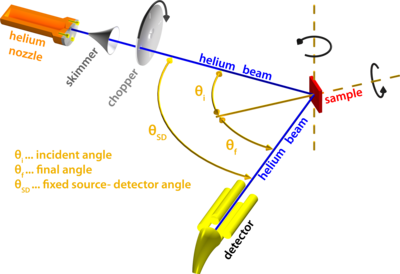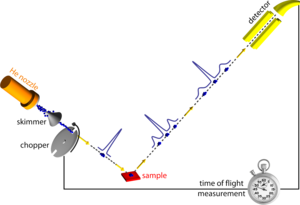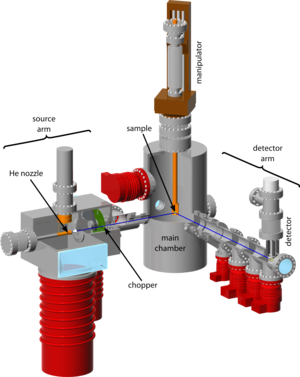Helium Atom Scattering
A short introduction on our work and helium atom scattering is given below starting with the components of a typical helium atom scattering apparatus.
Shematic drawing of a helium atom scattering machine:
Pure helium gas is used to create an atomic beam in a supersonic expansion whereupon the gas expands from a high pressure region (50 bar) through a small nozzle into a region of vacuum. The expansion gives rise to an adiabatic cooling of the gas whereupon the internal energy of the gas is transformed into translational kinetic energy. About 10 mm from the nozzle the outer part of the expanding gas cloud is separated from the forward moving atoms using a conical skimmer.
Further down the beam line a chopper can be located allowing time-of flight experiments by chopping the beam into short pulses.
The intense, nearly monoenergetic helium beam is then directed towards a target surface at a particular angle of incidence and the scattered intensity is monitored at a given angle using a mass spectrometer. Therefore the sample is mounted on a manipulator which allows to position and rotate the sample.
The inelastic scattering of helium atoms is used to determine surface phonon modes that is collective lattice vibrations at the surface. Thus the helium atom may either loose energy by exciting a phonon or gain energy via energy transfer from a phonon to the helium atom. The scattered helium atom exhibits an energy (velocity) that is lower/higher than the velocity before the interaction.
To achieve information about the different velocities in the helium beam a so called time-of-flight measurement is carried out. Therefore it is necessary to modulate the beam by a rotating chopper disk: A slit in the chopper rotates past the beam and chops the beam into narrow bunches of He-atoms. The atoms in the bunch are then propagating to the detector whereby faster atoms tend to arrive earlier at the detector than slower particles.


